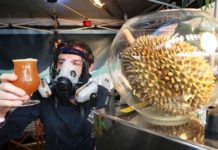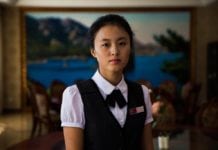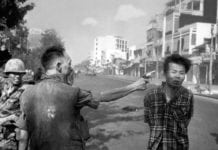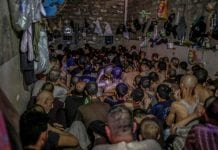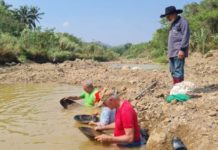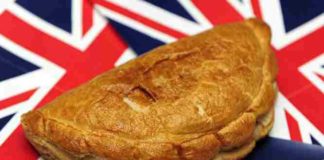
A survivor’s graphic memoir and a feature film reveal horrific exploitation and violence on the high seas – and the shame of the world’s complicity
In 2006, a young Cambodian sculptor, Vannak Anan Prum, left his village to look for labouring work.
He needed to earn enough money to pay for his wife Sokun’s impending hospital stay to give birth to their first child. He intended to be away for two months.
He would not see his wife again for five years. After a middleman on the Thai-Cambodian border promised he could earn a lot of money drying fish, Prum was sold into slave labour, sent to sea on a fishing trawler.
He was forced to work around the clock and through storms, allowed a maximum two hours’ sleep by day and two hours at night.
Violence happened on the boat every day for the next four years as a way of keeping those enslaved in line, Prum tells Guardian Australia through a translator.
He says people would disappear off the boats without warning, and were assumed to have been killed and thrown into the sea. One night, Prum says he saw one Thai worker cut another man’s head off with a cleaver.
Prum writes about and explicitly draws these horrific experiences in his new graphic memoir of modern slavery, The Dead Eye and the Deep Blue Sea.
The story includes his experience of jumping ship to attempt to swim to his escape, only to be sold by his “rescuers” into slavery on a palm oil plantation on the Malaysian coast.
His return home to his wife and the daughter born in his absence was eventually secured by LICADHO, a Cambodian human rights organisation, in 2011.
“There are many slaves who die in the ocean, and their children don’t know where they have gone,” says Prum.
“If we don’t share these stories, the world doesn’t know what’s going on in the middle of the ocean.”
The rest of the world is implicated in this slavery. Some of the “trash fish” caught by enforced labour on these boats gets used as pet food sold in supermarkets, as well as used as a cheap protein feed in prawn farming.
An estimated 200,000 migrant workers from Cambodia, Myanmar and Laos are prone to such exploitation by the $6.5 billion Thai fishing industry, according to the Raks Thai Foundation.
But the figures are hard to confirm, says Kate Kennedy, a former executive officer of Hagar Australia, part of an international organisation dedicated to restoring the lives of people broken by human trafficking.
The boys and men are typically “tricked” onto boats, says Kennedy, bonded with a debt that never goes away:
“They’re not being paid, they’re trapped on boats, and it’s particularly violent.” Ship captains use electric shock treatment, sleep deprivation and drugs to keep the labourers passive, she says.
In 2015, Hagar helped rehabilitate some of hundreds of boys and young men rescued in the Indonesian town of Benjina, which straddles two islands in the Indonesian province of Maluku, about 800 km north of Darwin.
The workers had been enslaved on Thai shipping trawlers for years, many incarcerated on the island in iron cages.
Most of those workers had seen a “demonstration murder”, says Kennedy, and post-traumatic stress is a “massive characteristic” of these victims.
Non-government organisations such as Hagar attempt to give these boys and men vocational training to repurpose their lives.
“A number ended up just going back into the fishing industry,” says Kennedy. “It was the only way they knew how to live, which was all so awful.”
Kennedy is an executive producer of a new live-action feature film, Buoyancy, by Melbourne director and writer Rodd Rathjen.
It is a story of the Thai fishing slave trade, and the characters’ experiences are based on Rathjen’s interviews with slavery survivors such as those on Benjina.
The movie, though fictional and unrelated to Prum’s slavery graphic memoir, is strikingly similar in its subject matter.
Buoyancy is naturalistic in style and uses untrained actors, including, in non-speaking roles, some who had been enslaved on trawlers “to varying degrees”, says Rathjen.
In his acting debut, Cambodian Sarm Heng plays Chakra, who is tricked onto a Thai fishing trawler where he witnesses violence, torture and murder.
Heng, a former street kid found by the casting director through Green Gecko, a non-government organisation in San Riep, was 14 at the time of filming, which took place over three weeks off the coast at Sihanoukville.
“Some of the things I asked Sarm to experience emotionally and psychologically were quite challenging for him,” says Rathjen.
“We just had to separate the acting from real life and throw our arms around him when we were finished shooting”.
Rathjen says that, speaking to survivors, he came to understand the “process of dehumanisation” that takes place on the boats, and he wants his Buoyancy audience to wonder whether the character of Chakra, also aged 14, will become violent like his captain, Rom Ran (played by Thanawut Kasro).
“I wanted to understand how you become capable of such brutality and inhumanity,” he says.
Kennedy says there has been a gradual trend in anti-slavery legislation towards supply chain reporting, commencing with California’s Transparency in Supply Chains Act 2010, and increased penalisation, with the US strengthening its powers to exclude companies from federal contracts if they fail to report on human trafficking in their supply chain.
In the UK, a recently concluded review of the Modern Slavery Act 2015 made recommendations to strengthen transparency in the supply chain, while in Australia, the Modern Slavery Act that came into effect this year compels companies turning over more than $100m per annum to report on their supply chains, with the first statements due in September next year.
Separate New South Wales legislation, not yet in effect, is expected to go further: companies with an annual revenue of more than $50m potentially face a $1m fine for slavery in their supply chain.
“The commonwealth is going for a ‘let’s expose’ [rather than penalty] first, giving companies a bit of time to get their fitness up about how they review their supply chain, because it’s not without complexity,” Kennedy says.
“There will be increasing discontent if companies are not reporting, or they’re not reporting well or taking remedy when they find slavery in the supply chain.”
The International Labour Office estimates that in 2016 there were 40.3 million people in modern slavery, including 24.9 million in forced labour (as well as 15.4 million in forced marriage).
A 2014 ILO report said there were profits of roughly $150bn a year for traffickers, consisting of $99bn from commercial sexual exploitation, $34bn in construction, managing and mining, $9bn in agriculture including forestry and fishing, and $8bn saved annually by private households that employ domestic workers under conditions of forced labour.
Vannak Anan Prum meanwhile is planning to make an animated feature based on his memoir, and his next book will be stories of other people’s slavery, including sex trafficking and women sold as brides.
“Every country must stop the slavery and human trafficking,” he says, “and private companies, please stop this exploitation.”
• Buoyancy is released in Australia on 26 September. The Dead Eye and the Deep Blue Sea is out now, published by Seven Stories Press, via Random House Australia







